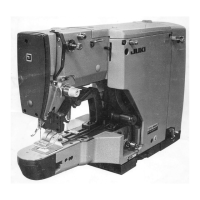4) Bobbin thread is too short.
A. If the bobbin thread extending from the
top
end
of
the
bobbin
case
finger
is
less
than22 mm(7/8"), the
machine may fail to form stitches (Fig. 23). Provide
a
little
more
distance
between
the
counter
knife
and
the needleplate needlehole
guide.
B.
If
the vertical distance between
the
needle plate
needle hole guide and the
counter
knife is
too
much,
the
thread
may
come
into
contact
with
the
counter
knife
and
may
be
broken.
C. If there is any burr or scratch on the shuttle surface
race spring at point
(§)
, it may cut or break the
bobbin thread. Make
part
(g)
smooth by the use
of
abrasives. (Fig. 24)
D. In
order
to prevent
the
bobbin
thread
from com-
ming
out
due to idle spinning
of
the bobbin, use
both
the
bobbin
and bobbin case specially designed
for
the
LK-980
model.
(2) Thread breakage
(1) Thread breakage when sewing
Phenomenon
Either
the
bobbin
or
the
needle
thread
is
acci
dentally
cut
while stitching.
Possible
causes
•The
shuttle
is
scratched.
•The
thread
is snagged in
the
shuttle.
•The
shuttle
driver
is
scratched.
•The
shuttle
driver
is
too
close
to
the
shuttle.
•The
needle plate needle hole guide is scratched.
•The
needle is touching
the
work
clamp foot.
•The
needle
is
scratched.
•The
needle
thread
tension
at
the
time
of
piercing
the
material
is
too
high.
•Timing
of
the feed cam
motion
is
not
correct.
Corrective
measures
1) Scratched shuttle (Fig. 25)
A. If the needle hits the shuttle, the blade point ® will be worn to a
knife edge. Carefully polish it with an oilstone and abrasives and keep
it slightly away from the needle point. However, do
not
push it back
too far from the needle to prevent stitch-skipping. Also, take care not
to provide
too
much clearance between
the
front face
of
the
shuttle
driver
and
the
needle
when
the
needle
bar
has
reached
its
lowest
position, in
order
to prevent the needld from bending. In such a case,
adjust the shuttle driver position in
the
axial direction, so
that
it
protects the needle. When the blade
point
of
the shuttle has been
seriously damaged, also check to see if the shadowed area (Fig. 26) on
the
rear face
of
the shuttle race is
of
the correct shape as illustrated.
If
not,
correct the shape with an oilstone.
B. If the needle is bent or broken, the shuttle may be damaged at point
® . This scratch may
damage
or break the needle thread when
releasing. This is the most frequent cause
of
this type
of
trouble.
C. A scratch at point © can only be made by a broken needle or
by carelesshandling
of
the needle when replacing the shuttle.
However, if the shuttle has a scratch at this point, the machine will
probably
not
be able to
stitch.
D. A scratch at point © may
damage
the thread when
releasing
and
result in thread breakage. This kind
of
trouble does
not
occur fre
quently except with synthetic thread.
s
(S>
Fig.
23
Fig.
24
Fig.
25
rr
Fig.
26

